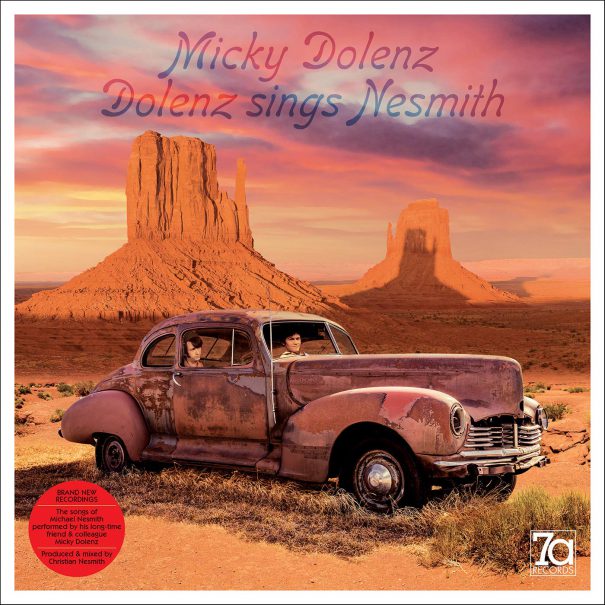REVIEW: Micky Dolenz makes the old sound new with ‘Dolenz Sings Nesmith’

Micky Dolenz and Michael Nesmith have been friends for a very long time, and for decades Dolenz has been part of a band—The Monkees—for which Nesmith was a primary songwriter. So Dolenz Sings Nesmith is not the first time Dolenz has sung Nesmith-penned songs.
Dolenz Sings Nesmith
Micky Dolenz
7a Records, May 21
7/10
So what’s new?
For one, it’s Dolenz’s first solo album in nine years, so for fans it’s a rare opportunity to hear how he’s doing. And from the sound of it, Micky Dolenz doing really well. Voices naturally change with age and not all singers are able to adapt their style to their new sound. But amazingly, the 76-year-old sounds remarkably like his younger self. Any change with time adds texture to the arrangements he gave to his friend’s songs. It’s a credit to not just Dolenz but Nesmith’s songwriting, as well as Nez’s son Christian Nesmith’s skills as a producer.
The simple arrangements through most of the album serve to drive home the tribute. They let Nesmith’s songwriting shine through, both musically and lyrically, in a way they couldn’t do as well through the Monkees‘ rock and pop psychedelia. Opening track “Carlisle Wheeling,” originally an unreleased Monkees song that turned into a Nesmith solo effort, is one of the more robust arrangements with strings and full band. Still, it’s an acoustic and relatively minimalist arrangement.
The second song is the album’s highlight. Linda Ronstadt classic “Different Drum,” from her time with the Stone Poneys, is a Nesmith song, but one he didn’t originally perform by himself or in one of his bands. The arrangement, a harmonica-heavy folk-rock treatment that feels more energetic than the original, is as close as anyone has come in a long time to translating late ’60s and early ’70s musical trends to modern sound and production. It doesn’t feel even the slightest bit dated despite its age.
Following that, “Don’t Wait For Me,” from the Monkees’ 1969 album Instant Replay, gives an idea of what the Monkees would have sounded like on MTV’s “Unplugged.” While the original was one of the band’s more mellow and country-inspired songs, Dolenz’s version is just a vocal track over an acoustic guitar.
“Marie’s Theme” is notable largely for the touch of synth, though it’s not surprising. Micky Dolenz famously bought the third-ever Moog synthesizer and played it on the Nesmith-penned “Daily Nightly,” making it one of the first rock songs to use the instrument. Was it an intentional homage? Almost definitely not, but it’s comforting to know that the more things change, the more they stay the same.
One thing that couldn’t be coincidental is the next pair of songs. “Nine Time Blue,” recorded in 1968 and played live on “The Johnny Cash Show” in 1969 but not released until 1987’s Missing Links, is turned into a piano ballad. It merges directly into “Little Red Rider,” originally by Nesmith’s First National Band, which is turned from its original keyboard, bass and drum song to Dolenz Sings Nesmith’s only full-blown rock and roll song. With all due respect to Nesmith, the latter sounds much better as a rock tune, and shows that Dolenz still has rock chops.
Perhaps the biggest change to a song’s character is “Circle Sky.” The version on Head is a fairly typical pop-rock song of the era, good but not groundbreaking in the era when the Beatles were experimenting with South Asian instruments and other new-to-the-rock-scene sounds. Micky Dolenz fixes that by opening his version of “Circle Sky” with Eastern strings and a heavy beat. His vocals evoke the soaring psychedelia of 1968 in a way the original definitely did not when it was released in 1968. It’s interesting to consider how the Monkees’ trajectory would have differed had they released this version back then, putting themselves on the cutting edge with the album rather than beginning the end.
Closing out the album is the banjo-intensive “Propinquity,” the trippy “Tapioca Tundra,” and the wistful and nostalgic-sounding “Only Bound.” Final track “You Are My One,” at a minute long, serves largely as an outro.
In addition to being a great tribute to Michael Nesmith sung by his friend and produced by his son, Dolenz Sings Nesmith shows that old dogs can learn new tricks. Whether the old dog is Dolenz himself—who sounds half his age across a variety of styles and genres—or whether the old dogs are the songs themselves—many of which still sound fresh 50 years after they were written—it’s an airtight case in favor of reexamining the classics.
Follow editor Daniel J. Willis at Twitter.com/BayAreaData.
